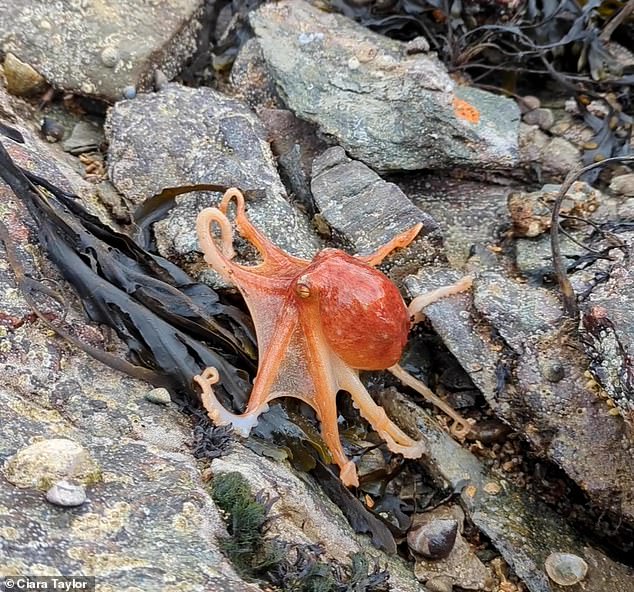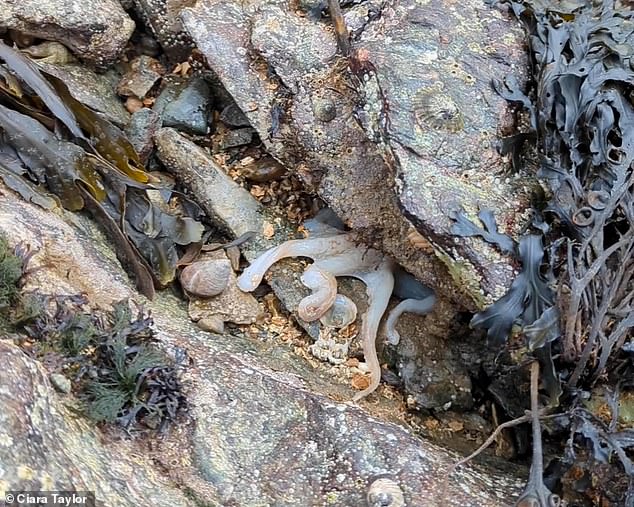Ever seen an octopus blush? In rare footage, a sea creature turns a brilliant red as it emerges from under a rock on a beach in Wales
Beachgoers have captured stunning footage of a ‘ruddy’ octopus emerging from its hiding place on a beach in Wales.
The curled octopus turns from ghostly white to deep orange-red as it crawls out from under a rock on the beach at Menai Bridge, Anglesey.
Experts believe the animal may have changed color when it detected people nearby and viewed them as a potential danger.
After crawling against the rocks with its long tentacles, it returned safely to the sea.
Octopuses have thousands of cells under their skin, each containing sacs filled with pigments of different colors.
The curly octopus (Eledone cirrhosa) starts out a ghostly shade of white before transitioning to a deep orange-red
By stretching or squeezing these sacs, they can quickly change the brightness of each of these colors.
The new footage was captured by Ciara Taylor, an assistant at the Marine Conservation Society (MCS), after being warned about a bunch of tentacles by other beachgoers.
“I met two other young people playing rock pool and one of them saw some tentacles sticking out from under a rock,” Taylor said.
“They shouted at me, so I ran over, and then we waited.
‘Finally it came out and started crawling back towards the sea – we couldn’t believe it.
‘It was a great reminder of the beautiful nature we have in North Wales and why we need to protect it.’
The curled octopus (Eledone cirrhosa) is not a rare species in British waters; In fact, it is found around the British coastline and also on beaches throughout Europe.
However, it is ‘very unusual’ to see out of the water and even rarer to capture its colour-changing action on film.

The sea creature crawled out from under a rock on the beach at Menai Bridge, Anglesey, North Wales

The beautiful creature turns a deep orange-red as it runs out from under the rock and crawls among the seaweed and shells
They are rarely recorded in large numbers, but this is often because they exhibit solitary behavior, are quite inactive during the day, spend a lot of time hidden and are generally very well camouflaged.
Angus Jackson, data officer at MCS, said it is “very difficult to figure out why the octopus changes colour” but it may have been trying to scare people off.
‘They have so many complex behaviors and use color change as part of their very varied forms of communication and for camouflage,’ she told MailOnline.
“It could be that it was to try to scare off the rock poolers who saw it as a predator, to camouflage against the rocks, a stress response from running out of water, or some other type of communication with cephalopods that we don’t even know about.” can reach. to suggest.’

The footage was captured by Ciara Taylor, an assistant at the Marine Conservation Society (MCS), after she was alerted to a telltale array of tentacles
The curled octopus is believed to be increasing in numbers and experts believe this may be due to a decline in their predators, such as cod, and rising sea temperatures due to climate change.
The MCS’s Seasearch programwhich asks divers and beachgoers to document marine life, reported an increase in sightings in 2022.
“Octopuses are incredibly intelligent and there is still so much to learn about them,” Jackson said.
‘By reporting sightings to us, or taking part in our Seasearch programme, you can help us build a picture of Britain’s marine life so we can help protect it.’
